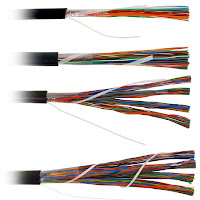·
Glossary
·
10Base2 - Ethernet specification
for thin coaxial cable, transmits signals at 10 Mbps (megabits per second) with
a distance limit of 185 meters per segment.
·
10Base5 - Ethernet specification
for thick coaxial cable, transmits signals at 10 Mbps (megabits per second)
with a distance limit of 500 meters per segment.
·
10BaseF - Ethernet specification
for fiber optic cable, transmits signals at 10 Mbps (megabits per second) with
a distance limit of 2000 meters per segment.
·
10BaseT - Ethernet specification
for unshielded twisted pair cable (category 3, 4, or 5), transmits signals at
10 Mbps (megabits per second) with a distance limit of 100 meters per segment.
·
100BaseT - Ethernet specification
for unshielded twisted pair cabling that is used to transmit data at 100 Mbps
(megabits per second) with a distance limit of 100 meters per segment.


